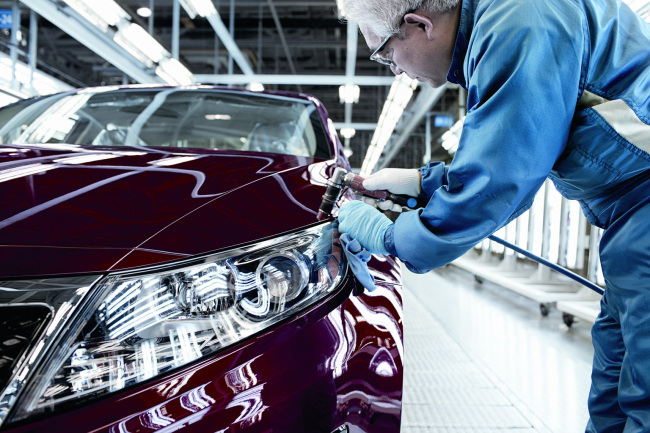ATLANTA, Georgia ― As West Point’s once-strong textile manufacturing industry started faltering in the early 2000s, jobs vanished fast and people were forced to leave their hometown some 130 kilometers from Atlanta.
Then, a “savior” announcement was made by Kia Motors, still an unfamiliar name to the residents at that time. The carmaker said it would build its first U.S. factory in the city, invest some $1.1 billion and hire some thousands of people.
“The news was almost a savior for the local economy,” said Page Estes, president of the Chamber of Commerce of Troup County. In order to mark the big investment, the city council renamed the access road Kia Boulevard.

An employee works on a vehicle at Kia Motors Manufacturing Georgia in West Point, Georgia, Tuesday. (Kia Motors)
After five years of construction, Kia ― affiliated with Hyundai Motor ― completed the 202,400-square-meter factory with an annual capacity of 300,000 vehicles in 2011 and started production in the same year.
This July, the plant’s cumulative car production exceeded the 1 million mark in just 44 months ― the shortest period for any Hyundai or Kia factory worldwide.
Located some 134 kilometers from Hyundai’s Montgomery factory in Alabama that opened in 2005, the new plant was a strategic decision. It has become a lot easier for the Korean duo to share their own auto parts and 105 suppliers there.
The Kia plant also produces the Hyundai Santa Fe sport-utility vehicle as well as two Kia models, the Optima (the K5 in Korea) and the Sorento R SUV.
As a result, Hyundai’s Alabama plant can focus more on building top-selling sedans such as the Sonata and the Avante.
In order to meet market demand more promptly, the Kia factory also adopted a three-shift system in June 2011 and hired an additional 823 workers. Until then, a two-shift system was more widely adopted within the U.S. automotive industry.
Despite incentives for extra work on weekends, workers saw an average of 20 percent wage cuts. But there was no serious resistance from them, according to Randy Jackson, HR vice president at the Georgia factory.
“We tried to make sure that there should be little difference in average salary per hour despite reduced working hours. Among other things, our members understand market conditions and support the company,” he said.
“Now many other companies are also following our three-shift operation. We are becoming a new model going forward.”
Troup County’s Estes understands that there is a stigma in Korea about reduced working hours and subsequent wage cuts, as well as about the powerful labor unions.
“But in the U.S. where health benefits are paid by the employer, job security and an employer that promises it are more important factors for workers,” she said.
More committed workers led to heightened productivity at both Hyundai-Kia’s U.S. factories. It takes 15.9 and 14.2 hours to make a car at the Georgia and Alabama plants, respectively ― almost half the 28.4 hours at Korean factories.
The presence of a car factory affected car sales positively as well. In the U.S., Kia’s market share almost doubled from 1.6 percent in 2006 to 3.8 percent to 2012.
Due to elevated brand awareness and car sales, the Kia factory is expected to post another record year for production, exceeding 367,000 vehicles.
“About production expansion, we are market-driven. We will continue to make efforts to ensure our preparedness for possible expansion,” said the vice president, hinting at no immediate plan for facility expansion.
By Lee Ji-yoon, Korea Herald correspondent
(jylee@heraldcorp.com)


![[KH Explains] No more 'Michael' at Kakao Games](http://res.heraldm.com/phpwas/restmb_idxmake.php?idx=645&simg=/content/image/2024/04/28/20240428050183_0.jpg&u=20240428180321)



